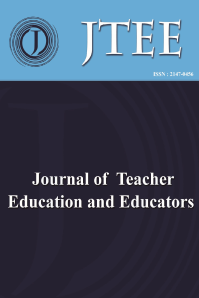-
-
Anahtar Kelimeler:
-
Inclusive Education as an Approach to Reduce Inequitable Access to Education: Exploring the practices of Jegnoch Metasebiya Primary School in Harar Town, Ethiopia
High-quality inclusive education program is indispensable to ensure access to education for children with disabilities. This study examined accessibility of instructional provision for children with disabilities. Qualitative, case study method was carried out, using purposive sampling followed by observation, interview and focus-group discussion to collect data. It begins with introducing how Inclusive education (IE) enhances learning accessible. Jegnoch Metasebiya Primary School is one of the schools awarded in the country for its best performance. The study revealed that the number students with disabilities enrolled in the school were not significant. It also found that the schooling and instructional activities were not accessible for the children. The study concluded that the school was implementing an integrated approach. Recommendations were made for the regional education office and the school to allocate adequate budget, promote inclusive education and to strengthen collaboration with all stakeholders
Keywords:
Inclusive education, primary school, children with disabilities equitable access to education,
___
- ACPF. (2012). Educating Children with Disabilities: Ethiopia The African Child Pol- icy Forum.
- Barton, E. E., & Smith, B. J. (2015). Advancing High-Quality Preschool Inclu- sion : A Discussion and Recommendations for the Field, (X). https://doi. org/10.1177/0271121415583048
- Behlol, M. G. (2011). Inclusive Education: Preparation of Teachers , 63–74.
- Boisseau, S., & Guy, M. (2012). Inclusive Education, (July).
- Booth, T., & Ainscow, M. (2011). index for inclusion.
- Bryman, A. (2006). Integrating quantitative and qualitative research: How is it done? Qualitative Research, 6(1), 97–113. https://doi.org/10.1177/1468794106058877
- Cohen, L., Manion, L., & Morrison, K. (2011). Research Methods in Education. Re- search methods in education. https://doi.org/10.1111/j.1467-8527.2007.00388_4.x
- Collins, M. (2012). Index for inclusion : developing learning and participation in schools. Educational Psychology in Practice theory , research and practice in educational psychology, 28(4). DOI: 10.1080/02667363.2012.728810
- Cologon, K. (2013). Inclusion in education: towards equality for students with dis- ability. Retrieved from www.cda.org.au/_literature_159457/Issues_Paper_on_In- clusion_-_PDF
- Coyle, A. (2016). Introduction to qualitative psychological research. Analysing Quali- tative Data in Psychology, 9–30.
- CSA, Central Statistics Authority (2008). Summary and Statistical Report of the 2007 Population and Housing Census. FDRE Population Census Commission. Addis Ababa.
- Dagnew, A. (2013). Factors Affecting the Implementation of Inclusive Education in Primary Schools of Bahir Dar Town Administration, 3(March), 59–67.
- DEC/NAEYC. (2009). Early childhood inclusion: A summary. Young Exceptional Children (Vol. 13). https://doi.org/10.1177/1096250609347736
- European Agency for Development in Special Needs Education. (2010). European Agency for Development in Special Needs Education. European Journal of Special Needs Education (Vol. 12). https://doi.org/10.1080/0885625970120109
- European Agency for Development in Special Needs Education. (2011). Key princi- ples for promoting quality in inclusive education, 1–26.
- European Agency for Development in Special Needs Education. (2013). ORGANISA- TION OF PROVISION TO SUPPORT INCLUSIVE EDUCATION: Literature Review.
- European Agency for Development in Special Needs Education, Borg, G., Hunter, J., Sigurjonsdottir, B., & D’Alessio, S. (2011). Key principles for promoting quality in inclusive education, 1–26.
- European Agency for Special Needs and Inclusive Education. (2017). Inclusive Early Childhood Education Literature Review.
- Franck, B. (2015). Inclusive Education and Children with Disabilities in Ethiopia.
- Guralnick, M. J., Connor, R. T., & Johnson, L. C. (2011). The Peer Social Networks of Young Children with Down Syndrome in Classroom Programmes. Journal of Ap- plied Research in Intellectual Disabilities, 24(4), 310–321. DOI:10.1111/j.1468- 3148.2010.00619.x
- Janney, R., & Snell, M. E. (2013). Teachers’ Guides to Inclusive Practices : Modifying Schoolwork, 223.
- John W.Cresswell. (2007). Qualitative_Inquiry_and_Research Design: Choosing among five approaches.
- Kearney, A. (2011). Exclusion from and within school.
- Lee, F. L. M., Yeung, A. S., Tracey, D., & Barker, K. (2015). Inclusion of children with special needs in early childhood education: What teacher characteristics matter. Topics in Early Childhood Special Education, 35(2), 79–88. https://doi. org/10.1177/0271121414566014
- Lewis, I., & Bagree, S. (2013). Teachers for All : Inclusive Teaching for Children with Disabilities, 24.
- Mkonongwa, L. M. (2014). TEN/MET Quality Education Conference 18th-19.
- Odom, S. L. (2016). Inclusion for Young Children With Disabilities : A Quarter Cen- tury of Research Perspectives, 344–356.
- Richards, G., & Armstrong, F. (2010). Teaching and learning in diverse and inclusive classrooms. New York, NY: Routledge.
- Shani, M., & Koss, C. (2015). Role perceptions of School Administration Team Members concerning inclusion of children with disabilities in elementary gen- eral schools in Israel. International Journal of Inclusive Education, 19(1), 71–85. https://doi.org/10.1080/13603116.2014.906666
- Tefera, B., Admas, F., & Mulatie, M. (2016). Education of Children with Special Needs in Ethiopia : Analysis of the Rhetoric of „ Education For All ‟ and the Re- ality on the Ground The Ethiopian government has registered a prodigious stride in improving educational access in the last couple of decade, XXXV(1), 45–97.
- Temesgen, Z. (2014). The Journey of Special Needs Education in Ethiopia : An over- view, 5(27), 83–86.
- Tirussew Teferra. (1995). Ethiopia - Baseline Survey on Disability. (tirussew et al?)
- Underwood, K., & Frankel, E. B. (2012). The Developmental Systems Approach to Early Intervention in Canada. Infants & Young Children, 25(4), 286–296. https:// doi.org/10.1097/IYC.0b013e3182673dfc
- UNESCO, United Nations Educational, Scientific and Cutural Organization (1994). the Salamanca Statement Framework. Policy, (June), 7–10. https://doi.org/E D -94/WS/ 1 8
- UNESCO, United Nations Educational, Scientific and Cutural Organization (2009). Policy Guidelines on Inclusion in Education.
- United Nations Educational, S. c and C. O. (2009). Policy Guidelines on Inclusion in Education.
- Wapling, L. (2016). Inclusive Education and Children with Disabilities: Quality edu- cation for All in Low and Middle Income Countries, (January).
- WHO, World Health Organization. (2011). WORLD REPORT ON DISABILITY.
- ISSN: 2147-0456
- Başlangıç: 2012
- Yayıncı: İlknur GÖKÇE
